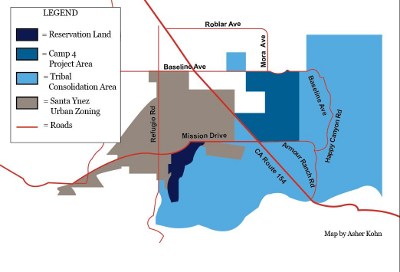The Sierra Club's Marin Group of chapters brought a court challenge July 10 seeking to reverse the Coastal Commission's May approval of the Marin County Land Use Plan Update.
Filed by attorney John E. Sharp of San Rafael, the writ petition alleges violations of the Coastal Act, principally in the update's provisions allowing farmers to obtain permits as of right for more houses and other structures under a broadened definition of "agriculture." It further alleges noncompliance with CEQA through failure to analyze feasible alternatives or mitigation measures -- an argument founded on the requirement that, although local coastal plan revisions need not prepare a full EIR, they must include findings functionally equivalent to those required by CEQA.
As of Monday county staff responded that they had not yet seen the suit and spokeswoman Sarah Christie said the Commission had not yet been served.
The Environmental Action Committee of West Marin (EAC), which had sought more development restrictions in the spring, chose not to file suit. Amy Trainer, executive director of EAC, listed continuing criticisms of the May-approved plan, but wrote: "EAC is committed to working with the Coastal Commission staff to address our concerns in the Implementation Plan. We decided that a lawsuit at this time was not in our best interest."
The contested update forms the initial, most substantial part of the pending Marin Local Coastal Program Amendment (LCPA), which would be the first update to the program since 1981. The Commission has been waiting to take up the implementing ordinances that complete the LCPA until they are rewritten to reflect the tangle of last-minute amendments that the Commission added to the Land Use Plan in May. (See http://www.cp-dr.com/articles/node-3493 for details from the meeting.)
A press release from the Sierra Club Marin Group quoted Executive Committee member Elena Belsky as warning that "if allowed to stand, the Commission's process and decisions regarding the Marin Local Coastal Plan Amendment will substantially weaken environment protections along the entire California coast." A further statement attributed to Belsky warned against "the precedent set of poor process and lack of environmental review, which could become the standard for updates of other LCPs around the state."
The release and petition said the existing plan failed sufficiently to respect public participation rights and to consider the plan's effects on natural habitats, the appearance of the area, and the preservation of prime farmland.
The petition included claims in an area disputed during the May hearing: that because the amended land use plan allows extra "intergenerational" farmhouses and other added farm housing, and because "the amendment redefines 'parcel' as 'legal lot of record'," the plan could "expose the coastal zone to over 1,000,000 [square feet] of new residential development on agricultural lands, insofar as conversion from 'parcel' to 'legal lot of record' can be accomplished administratively, without scrutiny or regulation."
It was not clear if this phrasing was meant to renew a concern raised in the May debate that permits for new farmhouses might be granted per 60-acre buildable lot, rather than allowing one set of the defined types of buildings on each entire farm.
Trainer did not respond to the text of the Sierra Club petition, but she appeared to take a different view in an email answering queries about EAC's decision not to sue. She wrote that the Commission had "clarified" that the allowed construction was per farm, not per legal lot.
But would that rule create an incentive to divide existing large farms into smaller 60-acre ones, potentially for hobby farmers? She wrote, "We are concerned about that but understand that most agricultural operators in the coastal zone have no intention currently to do this. We are hopeful that the Marin Agricultural Land Trust is working to secure both conservation easements and affirmative agricultural easements to prevent hobby farms."
(Arguments from Coastal Commission staff that each farm gets just one set of farm buildings appear in the first addendum to the staff report on Pages 8-9 of the PDF in the May agenda item packet at http://documents.coastal.ca.gov/reports/2014/5/Th12a-5-2014.pdf.)
The Sierra Club Marin Group's press release said the contested plan would allow construction of "between 129 and 210 new residences in the next ten years." As discussed at http://www.cp-dr.com/articles/node-3493, the potential number of houses that could be built on West Marin farmland under the new policy was calculated variously during the May debates as ranging from 110 under the county's view of conditions under the Land Use Plan, to a possible 263 if current Williamson Act restrictions on farmland were lifted.
Trainer's email and the Sierra Club press release each criticized the broadened definition of agriculture, which allows a first, second, and (on 180-acre properties) a third farmhouse to be built on each farm, with specified other structures allowed that could include 5000 feet of commercial processing space. The agricultural designation makes these principally permitted uses, allowable as of right and only appealable directly to the Commission in certain circumstances, such as for properties nearest coastlines or watercourses.
Trainer wrote, "Sometimes Marin County's Development Agency simply gets it wrong, and when that happens the public should absolutely have the right to seek review before the Coastal Commission."
EAC's past comments, like the Sierra Club's complaint, had called for environmental analysis that would qualify as the functional equivalent of an environmental impact report. In her recent email Trainer renewed a CEQA-type concern along similar lines that "little to no environmental cumulative impact analysis was performed" for "significant changes" to the LCP.
The Sierra Club press release pays extra attention to the role of Marin County Supervisor and Coastal Commission Chair Steve Kinsey, saying he has been criticized over the years for "aggressively promoting development" and saying he has discussed a wish to make the Commission "more 'streamlined' and 'user-friendly'".
The Sierra Club suit's docket is available at http://bit.ly/1p4rRbO. Belsky wrote that the petition would soon be posted on the Marin Group's Web site, which is at http://www.sanfranciscobay.sierraclub.org/Marin/.

